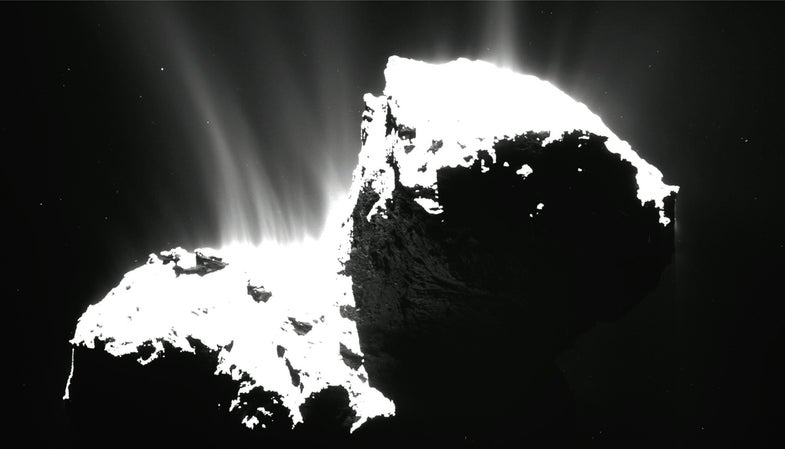5 Cool Things We Just Learned About Rosetta’s Rubber Ducky Comet
Even with a missing lander, the mission is sending back primo info

The Rosetta mission made history last year, by being the first manmade spacecraft to ever orbit or land on a comet. Things didn’t go exactly as planned, though. The lander Philae bounced around and got lost somewhere on the comet’s surface. Wherever it is, it’s not getting enough sunlight on its solar panels to keep it fully charged, so ESA has shut it down until the springtime, when the comet will be closer to the Sun. Meanwhile, the orbiter has been busy collecting data. The journal Science just published a boatload of new findings from the duck-shaped Comet 67P/Churyumov-Gerasimenko. Here are some of our favorites.
1. It’s like a candy bar. That’s what NBC says anyway, referring to the comet’s “dry, crunchy surface” and “soft, fluffy interior.” Radio waves reveal the comet’s inner structure is probably very porous—it’s less dense than water—while the outside is coated with dust. Yum.
2. Things are already heating up. As the comet’s orbit brings it closer to the Sun, the rising heat will cause dust and gas to fly off the comet’s surface. Rosetta will use various sensors analyze this comet debris, to figure out what the comet is made of. Already, “jets are sprouting up everywhere,” said astronomer Dennis Bodewits in a press release. “We’ve been surprised to see how active it is. It already has more jets than many other comets do at perihelion.” So far, it looks like most of the debris is coming off of the ‘neck’ of the comet, where the comet’s ‘head’ and ‘body’ join together, as well as the side facing the Sun.
3. Its odd shape is becoming more mysterious. Scientists don’t know whether the “rubber ducky” shape of the comet comes from two large rocks that fused together, or one large rock that eroded in a strange fashion. The vast amounts of dust spewing out from the ‘neck’ suggest it could be either, which isn’t particularly helpful. Scientists will need to compare the composition of both lobes to get a better idea.
4. The stuff of life is in short supply. Comets are like the fossil record of the solar system. Since many haven’t changed a whole lot since our planet was born, analyzing them can tell us what conditions were like way back then. Scientists are particularly interested in finding out whether organic molecules—the stuff that makes up living organisms—were scattered all over the solar system, thus increasing the chances that life could evolve on other planets. Or is Earth somewhat unique in that regard? An earlier study hinted at the possibility that complex organic molecules exist on the surface of 67P. Another team hunted for carboxylic acids, alcohols, and nitrogen-containing amines, but turned up mostly simple hydrocarbons.
5. Comet 67P may eventually split in two. As gas heats up inside the comet, it can vent out with explosive force, spewing dust and rocks and boulders everywhere. It can also cause cracks to form, like the one in the neck of the comet (photo below). Science News reports that the crack may expand over time and some day split the comet in two.

Split The Difference